Contact: Dan Krotz, (510) 486-4019, [email protected]
The gap between the marketplace and Berkeley Lab’s clean technologies has narrowed, thanks to a new program that drew more than 100 students, scientists, venture capitalists, and industry representatives from companies like AT&T and Pacific Gas & Electric Co. to the UC Berkeley campus on December 4th.
They came to hear what eight teams of UC Berkeley graduate students had to say about the commercial viability of a handful of Berkeley Lab innovations that reduce adverse environmental impacts and promote sustainability.
The students, who study law, business, public policy, and engineering, spent the last ten weeks asking the kinds of questions not often found in scientific analyses: What are the roadblocks to implementation? Does it have revenue potential? Is it likely to be backed by venture capitalists?

UC Berkeley graduate physics student Mickey Holcomb discusses the market potential for low-cost photovoltaic devices developed by Berkeley Lab's Samuel Mao and Robert Kostecki.
Some students even hit the pavement and rounded up potential investors who may be interested in backing the technologies.
Their work is at the heart of a recently launched program called Cleantech to Market, or C2M for short, which is a partnership between Berkeley Lab’s Technology Transfer and Intellectual Property Management Department and the Berkeley Energy and Resources Collaborative, an organization founded by MBA students at UC Berkeley’s Haas School of Business.
“The student teams can drill more deeply into these technologies than we in Tech Transfer have the resources to do, given that we market 40 to 50 technologies a year,” says Robin Johnston, a licensing analyst in the Technology Transfer and Intellectual Property Management Department who helped launch the program. “The program is also creating for the Lab what universities with business schools take for granted: entrepreneurial alumni who look to their alma maters for resources such as people, ideas, and in this case, technology.”
The student-led market research, which started this semester as a pilot program, seeks to provide greater exposure for promising Lab technologies, foster connections with the entrepreneurial and venture capital community, and spur the adoption of innovative business practices and policies that promote energy efficiency.
In the program’s first batch of projects, eight teams totaling 40 students were matched with a who’s who of Berkley Lab clean energy technologies: advanced biofuels, a novel solar chemical storage invention, a fabrication method for photovoltaic devices, an innovative electrolyte for batteries, and a low-cost water purification system. Other teams pored over strategies for implementing smart facades for efficient buildings, low roll resistant tires, and intellectual property and business models for developing countries.
The students’ work culminated in market analyses, financial models, and recommendations that were presented at the Dec. 4 event. The reports were prepared with help from the Berkeley Lab scientists who developed the technologies, as well as outside experts such as venture capitalists, business attorneys, and industry reps.
For some Berkeley Lab scientists, a market analysis and economic feasibility study wasn’t the only benefit of the cross-disciplinary collaboration.
“A significant value of the team for me was in rounding up venture capital groups who were likely to be interested in the technology,” says Elton Cairns, a scientist in the Environmental Energy Technologies Division who developed a high conductivity electrolyte for lithium ion batteries suitable for electronics and automotive applications.

Blake Holland, who is pursuing joint degrees in law and business, introduces the audience to the energy-saving advantages of electrochromic windows as fellow team member and MBA student Ari Frankel looks on.
“The team really went out and shook the bushes and found some venture capitalists,” adds Cairns, who recently met with members of the venture capitalist community thanks to his team’s legwork. “Students in the business school and the business school faculty have some great contacts — which is a great value to us.”
Students also came out ahead, according to Scott Harrington, an engineering student who worked on the battery electrolyte technology project. “It was a valuable experience to meet with venture capital firms and talk to people involved with the implementation of battery technologies. Many of the outside partners were extremely helpful in giving us feedback to improve our sales pitch and mentoring our team.”
Robert Kostecki, another scientist in the Environmental Energy Technologies Division who worked with a team that analyzed his fabrication method for a high efficiency solid state photovoltaic device, welcomed the students’ fresh take on innovations developed in the lab.
“Having young people interested in the scientific community provides us with an opportunity for a reality check,” Kostecki said at the Dec. 4 event. “Some of the ideas that we develop in the lab have to be verified in the real world, and that’s where the link between the scientific community and the business community comes in.”
Adds Johnston, “The program is also creating buzz. A VC I met with today, who heard of the program through a colleague at another firm, wants to be involved as an advisor or sponsor next semester. He’ll get exposed to a whole set of new technologies, inventors, and promising entrepreneurs.”
Expect the buzz to increase. Another round of Cleantech to Market projects is planned to start in January.
Additional Information:
- Go here to learn more about Cleantech to Market
- Learn more about Berkeley Lab’s Technology Transfer and Intellectual Property Management Department